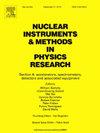利用光学读出 Micromegas 和 GEM 探测器的点扩散函数提取进行空间分辨率研究
IF 1.4
3区 物理与天体物理
Q3 INSTRUMENTS & INSTRUMENTATION
Nuclear Instruments & Methods in Physics Research Section A-accelerators Spectrometers Detectors and Associated Equipment
Pub Date : 2024-10-07
DOI:10.1016/j.nima.2024.169933
引用次数: 0
摘要
光学读出气态探测器用于需要高颗粒度图像的轨迹重建和成像应用。在决定分辨率的因素中,放大阶段起着至关重要的作用,因此需要对探测器的几何形状进行优化,以最大限度地提高空间分辨率。为了比较微图案气态探测器(MPGD)技术,我们利用 SOLEIL 同步加速器设施的聚焦低能 X 射线束记录并提取了微网状气态结构(icromegas)和气体电子倍增器(GEM)探测器的点扩散函数宽度。MICRO-Mesh 气体结构(icromegas)和气体电子倍增器(GEM)探测器的点扩散函数宽度分别为 ≈108 µm 和 ≈127 µm。使用不同强度、能量和横跨探测器有效区域的光束扫描可用于量化限制分辨率的因素,并利用 MPGD 放大级改进成像探测器。本文章由计算机程序翻译,如有差异,请以英文原文为准。
Spatial resolution studies using point spread function extraction in optically read out Micromegas and GEM detectors
Optically read out gaseous detectors are used in track reconstruction and imaging applications requiring high granularity images. Among resolution-determining factors, the amplification stage plays a crucial role and optimizations of detector geometry are pursued to maximize spatial resolution. To compare Micro Pattern Gaseous Detector (MPGD) technologies, focused low-energy X-ray beams at the SOLEIL synchrotron facility were used to record and extract point spread function widths with MICRO-Mesh Gaseous Structure (icromegas) and Gas Electron Multiplier (GEM) detectors. Point spread function width of 108 µm for Micromegas and 127 µm for GEM foils were extracted. The scanning of the beam with different intensities, energies and across the detector active region can be used to quantify resolution-limiting factors and improve imaging detectors using MPGD amplification stages.
求助全文
通过发布文献求助,成功后即可免费获取论文全文。
去求助
来源期刊
CiteScore
3.20
自引率
21.40%
发文量
787
审稿时长
1 months
期刊介绍:
Section A of Nuclear Instruments and Methods in Physics Research publishes papers on design, manufacturing and performance of scientific instruments with an emphasis on large scale facilities. This includes the development of particle accelerators, ion sources, beam transport systems and target arrangements as well as the use of secondary phenomena such as synchrotron radiation and free electron lasers. It also includes all types of instrumentation for the detection and spectrometry of radiations from high energy processes and nuclear decays, as well as instrumentation for experiments at nuclear reactors. Specialized electronics for nuclear and other types of spectrometry as well as computerization of measurements and control systems in this area also find their place in the A section.
Theoretical as well as experimental papers are accepted.

 求助内容:
求助内容: 应助结果提醒方式:
应助结果提醒方式:


